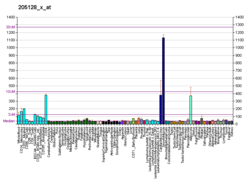Function
Prostaglandin-endoperoxide synthase (PTGS), also known as cyclooxygenase (COX), is the key enzyme in prostaglandin biosynthesis. It converts free arachidonic acid, released from membrane phospholipids at the sn-2 ester binding site by the enzymatic activity of phospholipase A2, to prostaglandin (PG) H2. The reaction involves both cyclooxygenase (dioxygenase) and hydroperoxidase (peroxidase) activity. The cyclooxygenase activity incorporates two oxygen molecules into arachidonic acid or alternate polyunsaturated fatty acid substrates, such as linoleic acid and eicosapentaenoic acid. Metabolism of arachidonic acid forms a labile intermediate peroxide, PGG2, which is reduced to the corresponding alcohol, PGH2, by the enzyme's hydroperoxidase activity.
While metabolizing arachidonic acid primarily to PGG2, COX-1 also converts this fatty acid to small amounts of a racemic mixture of 15-Hydroxyicosatetraenoic acids (i.e., 15-HETEs) composed of ~22% 15(R)-HETE and ~78% 15(S)-HETE stereoisomers as well as a small amount of 11(R)-HETE. [12] The two 15-HETE stereoisomers have intrinsic biological activities but, perhaps more importantly, can be further metabolized to a major class of anti-inflammatory agents, the lipoxins. [13] In addition, PGG2 and PGH2 rearrange non-enzymatically to a mixture of 12-Hydroxyheptadecatrienoic acids viz.,1 2-(S)-hydroxy-5Z,8E,10E-heptadecatrienoic acid (i.e. 12-HHT) and 12-(S)-hydroxy-5Z,8Z,10E-heptadecatrienoic acid plus Malonyldialdehyde. [14] [15] [16] and can be metabolized by CYP2S1 to 12-HHT [17] [18] (see 12-Hydroxyheptadecatrienoic acid). These alternate metabolites of COX-1 may contribute to its activities.
COX-1 promotes the production of the natural mucus lining that protects the inner stomach and contributes to reduced acid secretion and reduced pepsin content. [19] [20] COX-1 is normally present in a variety of areas of the body, including not only the stomach but any site of inflammation.
This page is based on this
Wikipedia article Text is available under the
CC BY-SA 4.0 license; additional terms may apply.
Images, videos and audio are available under their respective licenses.

























